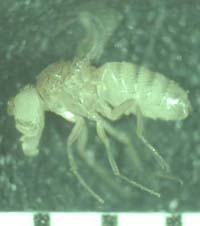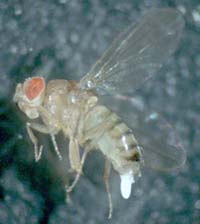 |
Figure 1: This wild-type (i.e. normal) culture of D. melanogaster, called Oregon R, contains eggs, larvae (maggots), pupae and adult flies. The vial is three inches high and ~1 inch wide. |
Research interests:
Female sperm storage and use in the fly, Drosophila melanogaster
Introduction:
My research focuses on the general question: What do females do with all of the sperm they receive during mating? This question stems from the observation that in most animals with internal fertilization, many more sperm are transferred during mating than are ultimately used to fertilize the female's eggs. In many of these animals, the female reproductive tract is a complex and dynamic landscape through which sperm traverse. This landscape contains specific regions and/or structures which are specialized for retaining sperm after insemination, a phenomenon called female sperm storage. Sperm entering the female reproductive tract (and the sperm storage organs in particular) have several potential fates including: fertilization, death/digestion, and/or expulsion from the female. Although female sperm storage is a common phenomenon in the animal world and an understanding of its role and male and female fitness is emerging, a detailed understanding of the molecular and physiological mechanisms of female sperm storage remain poorly understood.
Ultimately, I am interested in how females manage sperm in order to better understand the fitness consequences of female sperm storage. This research is classified as basic research since it addresses questions about fundamental biological processes. Information gained from this research can contribute to our understanding of animal development, reproductive behavior, physiology, and insect management strategies (both control and conservation).
The model organism Drosophila melanogaster:
While female sperm storage has been documented in animals from mammals to reptiles to worms and snails, insects present a particularly tractable study system. I use the well-established animal model Drosophila melanogaster (a.k.a. the fruit fly) to study mechanisms of female sperm storage. There are several reasons why D. melanogaster is appropriate to use for these types of studies.
1. Fruit flies are easy to maintain within a laboratory. They are small, develop rapidly, and have relatively simple dietary requirements.
 |
Figure 1: This wild-type (i.e. normal) culture of D. melanogaster, called Oregon R, contains eggs, larvae (maggots), pupae and adult flies. The vial is three inches high and ~1 inch wide. |
2. There are literally thousands of different genetic stocks (many carry specific mutations) available that serve as 'tools' to examine physiological processes. Furthermore, D. melanogaster's genome has been sequenced facilitating the identification of genes involved in physiological processes such as female sperm storage.
 |
Figure 2: This fly possesses several phenotypic mutations including curly wings, white eyes, and stubby thoracic bristles. These types of flies are useful for mapping (locating) other mutations to specific chromosome regions. The scale on the bottom of the image indicates millimeters. |
3. The behavior and ecology of these flies have been examined permitting the physiological basis of these phenomena to be examined.
 |
Figure 3: Oogenesis, fertilization and egg deposition are active areas of research. The female fly shown here is extruding an egg from her ovipositor. |
Therefore, this animal serves as a tractable system to understand the genetic basis of physiological mechanisms while still allowing one to relate that understanding to the whole animal.
Research Program:
My research students and I utilize genetic and physiological approaches to identify and describe female influence(s) on sperm storage and use in Drosophila melanogaster. Research objectives include:
Students working in my laboratory acquire valuable skills in experimental design and data analysis, insect husbandry, microscopy and genetics.
Other links of interest: